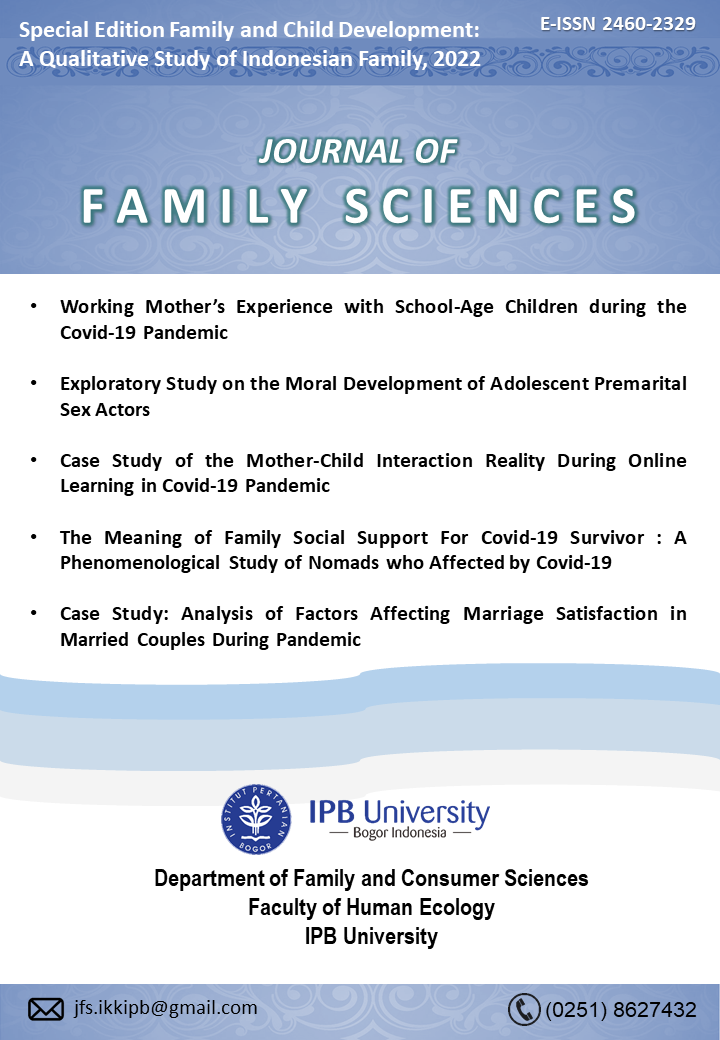Exploratory Study on the Moral Development of Adolescent Premarital Sex Actors
Exploratory Study on the Moral Development of Adolescent Premarital Sex Actors
Abstract
Premarital sexual behavior among teenagers is getting higher. The low level of moral education and failure in the division of roles, functions, and duties in the family triggers adolescents to behave freely and even violate religious and social norms. This research was conducted to look at the description of moral development and the factors that cause adolescents to have premarital sex. This study uses a qualitative method with a phenomenological research design with a purposive sampling technique. The research was conducted in Bogor Regency. Respondents in this study were teenage girls and boys and their biological mothers, totaling four people. This study indicates that all participants feel that the moral education they have received so far is not understood and even applied in everyday life. Teenagers have understood premarital sex behavior but have a different interpretation of it. This is due to several factors that cause teenagers to have premarital sex, such as lack of attention from parents, failure of family functions, lack of moral and character education, and environmental influences.
Downloads
References
Amrillah. (2006). Perilaku Seksual Wabal ditinjau dari Kualitas Komunikasi Orang Tua-Anak tentang Seksualitas. UMS Surakarta.
Anggiani, V., Hernawaty, T., & Widianti, E. (2020). Adolescent attitudes towards premarital sexual behavior (Sikap remaja terhadap perilaku seks pranikah). Jurnal Keperawatan Jiwa, 8(4), 411–420. https://doi.org/10.26714/jkj.8.4.2020.411-420
Azinar, M. (2013). Premarital sexual behavior is risky for unwanted pregnancy (Perilaku seksual pranikah berisiko terhadap kehamilan tidak diinginkan). KEMAS: Jurnal Kesehatan Masyarakat, 8(2). https://doi.org/10.15294/kemas.v8i2.2639
BKKBN. (2018). Survei demografi kesehatan Indonesia 2017: Kesehatan reproduksi remaja. Demographic and Health Survey (DHS).
Blanc, A. K., & Way, A. A. (1998). Sexual behavior and contraceptive knowledge and use among adolescents in developing countries. Studies in Family Planning, 29(2), 106–116. Retrieved from https://pubmed.ncbi.nlm.nih.gov/9664626/
Bourgeois, P., & Wolfish, M. (1994). Changes in You and Me: a Book aboutPuberty, Mostly for Girls. USA: Andrews And McMeel.
Djamba, Y. (2013). Sexual Practices in Africa. International Handbook on The Demography of Sexuality Dordrecht (A.K. Bauml). New York: Springer New York LLC.
Fitrian, H., Suwarni, L., & Hernawan, A. D. (2019). Determinants of adolescent premarital sex behavior in Pontianak City in 2019 (Determinan perilaku seks pranikah remaja di Kota Pontianak tahun 2019). Jurnal Vokasi Kesehatan, 5(2), 107–114.
Ghony, M. D., & Almanshur, F. (2014). Metodologi Penelitian Kualitatif. Jakarta: AR-RUZZ Media.
Gunawan, I. (2013). Metode Penelitian Kualitatif. Teori dan Praktek. Jakarta: Bumi Aksara.
Herawati, Y., & Marlina, L. (2007). Relationship of knowledge about sexually transmitted diseases with adolescent sexual behavior (Hubungan pengetahuan tentang penyakit menular seksual dengan perilaku seksual remaja). Sehat Masada Jurnal Penelitian Kesehatan Dharma Husada, 1(1), 55–64.
Indrijati, H. (2017). Internet use and adolescent premarital sexual behavior (Penggunaan internet dan perilaku seksual pranikah remaja). Prosiding Temu Ilmiah Nasional X Ikatan Psikologi Perkembangan Indonesia, 1, 44-51. Retrieved from http://jurnal.unissula.ac.id/index.php/ippi/article/view/2178/1641
Kesetyaningsih, T., Ana, M., & Sri, S. (2015). Knowledge about sexually transmitted diseases, attitudes and free sex behavior in Islamic and Public High School students in Yogyakarta (Pengetahuan tentang penyakit menular seksual , sikap dan perilaku seks bebas pada siswa Sekolah Menengah Atas Islam dan Umum di Yogyakarta). Mutiara Medika, 15(2), 116–123. https://doi.org/10.18196/mmjkk.v15i2.3758
Kirby, D. B., Laris, B. A., & Rolleri, L. A. (2007). Sex and HIV education programs: their impact on sexual behaviors of young people throughout the world. Journal of Adolescent Health, 40(3), 206–217. https://doi.org/10.1016/j.jadohealth.2006.11.143
Kohlberg, L. (1976). Moral stages and moralization: The cognitive-developmental approach. In T. Lickona (Ed.), Moral Development and Behavior: Theory and Research and Social Issues, 31-53. New York, NY: Holt, Rienhart, and Winston.
Lickona, T. (1976). Moral Development and Behavior: Theory, Research, and Social Issues.
Lickona, T. (1978). Moral development and moral education. In Knowledge and development (pp. 21–74). Springer.
Lubis, D. P. U. (2017). The role of peers and exposure to pornographic media on adolescent sexual behavior at the Yogyakarta Health Sciences College (Peran teman sebaya dan paparan media pornografi terhadap perilaku seksual remaja di Sekolah Tinggi Ilmu Kesehatan Yogyakarta). Jurnal Kesehatan Samodra Ilmu, 8(1), 47–54. Retrieved from https://stikes-yogyakarta.e-journal.id/JKSI/article/view/65
Mahmudah, M., Yaunin, Y., & Lestari, Y. (2016). Factors associated with adolescent sexual behavior in Padang City (Faktor-faktor yang berhubungan dengan perilaku seksual remaja di Kota Padang). Jurnal Kesehatan Andalas, 5(2), 448–455. https://doi.org/10.25077/jka.v5i2.538
Mangando, E., Lampus, B., Siagian, I., Kandou, G., Pandelaki, A., & Kaunang, W. (2014). The relationship between knowledge and attitudes of adolescents with premarital sex in Class Xi students at SMK Negeri 2 Manado (Hubungan antara pengetahuan dan sikap remaja dengan tindakan seks pranikah pada siswa Kelas Xi di SMK Negeri 2 Manado). Jurnal Kedokteran Komunitas dan Tropik, 2(1), 37–43. Retrieved from https://ejournal.unsrat.ac.id/index.php/JKKT/article/view/4635/4163
Migiana, F. D., & Desiningrum, D. R. (2015). Premarital sex for adolescents: a phenomenological study of adolescents who have premarital sex (Seks pranikah bagi remaja: studi fenomenologis pada remaja yang melakukan hubungan seksual pranikah). Empati, 4(1), 88–93. Retrieved from https://ejournal3.undip.ac.id/index.php/empati/article/view/13122
Moleong, L. J. (2019). Metodologi Penelitian Kualitatif (Edisi Revisi). Jakarta: PT. Remaja Rosda Karya
Mulyadi, M. (2018). Tingkah Laku Remaja dan Permasalahannya. Al-Taujih. Retrieved from https://ejournal.uinib.ac.id/jurnal/index.php/attaujih/article/view/509
Ningrum, D. (2015). Moral decline among adolescents: a study on parenting styles and etiquette teaching (Kemerosotan moral di kalangan remaja: sebuah penelitian mengenai parenting styles dan pengajaran adab). Values Innovation Perfection, 37(82), 18-30. Retrieved from https://journal.uii.ac.id/Unisia/article/view/10491
Pricylia, A. (2012). Hubungan antara penalaran moral dengan sikap terhadap perilaku seks pranikah pada remaja putri (Skripsi). Program Studi Bimbingan Konseling & Psikologi, Universitas Negeri Malang, Malang.
Purnama, Y. (2020). Factors that cause free sex (Faktor penyebab seks bebas). Jurnal Ilmiah Indonesia, 5(2), 156–163. https://doi.org/10.36418/syntax-literate.v5i2.933
Puspitasari, F. (2006). Perkawinan usia muda: faktor-faktor pendorong dan dampaknya terhadap pola asuh keluarga (studi kasus di Desa Mandalagiri, Kecamatan Leuwisari, Kabupaten Tasikmalaya) (Skripsi). Program Studi Hukum dan Kewarganegaraan, Universitas Negeri Semarang, Semarang.
Qomarasari, D. (2015). Hubungan antara peran keluarga, sekolah, teman sebaya, pendapatan keluarga, media informasi dan norma agama dengan perilaku seksual remaja SMA di Surakarta (Theses). Program Studi Ilmu Kesehatan Masyarakat, Universitas Sebelas Maret Surakarta, Surakarta.
Rachman, F. M. (2014). Islamic Teen Parenting. Jakarta: Erlangga.
Rahardjo, W., Citra, A. F., Saputra, M., Damariyanti, M., Ayuningsih, A. M., & Siahay, M. M. (2017). Premarital sexual behavior in college students: Looking at the role of self-esteem, relationship commitment, and attitudes towards premarital sexual behavior (Perilaku seks pranikah pada mahasiswa: Menilik peran harga diri, komitmen hubungan, dan sikap terhadap perilaku seks pranikah). Jurnal Psikologi, 44(2), 139–152. https://doi.org/10.22146/jpsi.23659
Rahyani, K. Y., Utarini, A., Wilopo, S. A., & Hakimi, M. (2017). Teenagers' premarital sex behavior (Perilaku seks pranikah remaja). Kesmas: National Public Health Journal 7(4), 180-185. https://doi.org/10.21109/kesmas.v7i4.53
Ramadhani, A., & Retnowati, S. (2013). Depression in adolescent victims of bullying (Depresi pada remaja korban bullying). Jurnal Psikologi, 9(3), 73-79. Retrieved from http://ejournal.uin-suska.ac.id/index.php/psikologi/article/view/165/151
Rumini, S., & Sundari, S. (2004). Perkembangan Anak dan Remaja. Jakarta: Rineka Cipta.
Sari, D. K., & Taviv, Y. (2010). Parental communication and sexual behavior of youth at Vocational High Schools in Baturaja City (Komunikasi orang tua dan perilaku seksual remaja Sekolah Menengah Kejuruan di Kota Baturaja). Jurnal Pembangunan Manusia, 4(11), 1-19. Retrieved from https://www.ejournal.sumselprov.go.id/pptk/article/view/190/111
Sarwono. (2006). Psikologi Remaja. Jakarta: Rajawali Press.
Satori, D., & Komariah, A. (2009). Metodologi Penelitian Kualitatif. Jakarta: Alfabeta.
Setiabudi, F., Awaru, O. T., & Irwansyah, I. (2021). Kabupaten Sinjai. Pinisi Journal of Sociology Education Review, 1(3), 113–119.
Smith, P. (1977). Moral Development and Behavior—Theory, Research, and Social Issues edited by Thomas Lickona. New York: Holt, Rinehart and Winston, 1976. 430 pp. The Educational Forum, 41, 502–506.
Strauss, A., & Corbin, J. (2003). Dasar-dasar Penelitian Kualitatif. Jakarta: Pustaka Pelajar.
Ulwan, N. A. (2012). Tarbiyatul Aulad fii Islam (A. R. Hakim, Penerj). Insan Kamil Solo.
Widyastuti, E. S. A. (2009). Personal and social that affect adolescent attitudes towards premarital sex (Personal dan sosial yang mempengaruhi sikap remaja terhadap hubungan seks pranikah). Jurnal Promosi Kesehatan Indonesia, 4(2), 75–85. https://doi.org/10.14710/jpki.4.2.75-85
Winurini, S. (2019). Studying adolescent moral intelligence through moral competency inventory (study on students in Bali) (Telaah kecerdasan moral remaja melalui moral competency inventory (studi pada pelajar di Bali)). Aspirasi: Jurnal Masalah-Masalah Sosial, 7(2), 187-197. https://doi.org/10.46807/aspirasi.v7i2.1289
Copyright (c) 2022 Journal of Family Sciences

This work is licensed under a Creative Commons Attribution 4.0 International License.
Authors who publish with this journal agree to the following terms:
- Authors retain copyright and grant the journal right of first publication with the work simultaneously licensed under

This work is licensed under a Creative Commons Attribution 4.0 International License. that allows others to share the work with an acknowledgement of the work's authorship and initial publication in this journal. - Authors are able to enter into separate, additional contractual arrangements for the non-exclusive distribution of the journal's published version of the work (e.g., post it to an institutional repository or publish it in a book), with an acknowledgement of its initial publication in this journal.
- Authors are permitted and encouraged to post their work online (e.g., in institutional repositories or on their website) prior to and during the submission process, as it can lead to productive exchanges, as well as earlier and greater citation of published work (See The Effect of Open Access).



_001.png)



